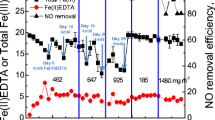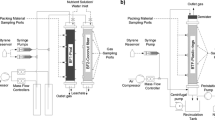Abstract
The microbes ofPseudomonas putida (KCTC1768) were fixed on the biofilter-packing media comprising an equivolume mixture of granular activated carbon (GAC) and compost, by recycling the liquid medium containing incubatedPseudomonas putida (KCTC1768). A biofilter experiment was performed to observe its transient behavior under the operating condition of 2,180 ppmv of ethanol-inlet concentration and 158 g/m3/h of ethanol-inlet load for the five consecutive temperature-stages of operation ranging from 25 °C to 40 °C. For the five temperaturestages of operation their removal efficiencies were measured and were compared with each other. The optimum operating temperature of the biofilter turned out to beca. 30 °C, which was consistent with the previous experimental result of Lim and Park. However, the optimum incubation-temperatures ofPseudomonas putida (KCTC1768) and the equivalent (i.e., NCIMB8858) were announced to be of 26 °C and 25 °C by Korea Collection for Type Cultures (KCTC) and National Collections of Industrial, Food and Marine Bacteria (NCIMB), respectively. It was also confirmed by the experiment in which the microbes were incubated in the same liquid medium as in the previous work of Lim and Park at temperature ranging from 20 °C to 40 °C and their growth rates were subsequently measured. Thus, the optimum operating temperature of a biofilter inoculated withPseudomonas putida (KCTC 1768) was proved to be 30 °C, which was higher than its optimum incubation-temperature byca. 5 °C
Similar content being viewed by others
References
Alagappan, G. and Cowan, R. M., “Effect of Temperature and Dissolved Oxygen on the Growth Kinetics ofPseumonas putida F1 Growing on Benzene and Toluene,”Chemosphere,54, 1255 (2004).
Annadurai, G., Juang, R.-S. and Lee, D.-J., “Microbial Degradation of Phenol using Liquorsof Pseudomonas putida and Activated Sludge,”Waste Management,22, 703 (2002).
Bohn, H. L.,Soil Treatment of Organic Waste Gases, Soils for Management of Organic Wastes and Wastewaters, ASA-CSSA-SSSA, Madison, WI, pp. 607–618 (1977).
Jones, A. and Turner, J. M., “Microbial Metabolism of Amino Alcohols; 1-Aminopropan-2-ol and Ethanolamine Metabolism via Propionaldehyde and Acetaldehyde in a Species of Pseudomonas,”Biochem. J.,134, 167 (1973).
Leson, G. and Winer, A. M., “Biofiltration: An Innovative Air Pollution Control Technology for VOC Emissions,”Journal of the Air & Waste Management Association,41, 1045 (1991).
Lim, K. H. and Park, S. W., “The Treatment of Waste-air Containing Mixed Solvent Using a Biofilter; 1. Transient Behavior of Biofilter to Treat Waste-air Containing Ethanol,”Korean J. Chem. Eng.,21, 1161(2004).
Lu, C., Lin, M. R. and Chu, C., “Temperature Effects of Trickle-bed Biofilter for Treating BTEX Vapors,”J. Environ. Eng.,56, 775 (1999).
Metcalf and Eddy Inc.,Wastewater Engineering: Treatment, Disposal and Reuse, Tata Mcgrow Hill Publishing Company, New Delhi (1996).
Ottengraf, S. P. P.,Exhaust Gas Purification, Biotechnology (H. J. Rehm, G. Reed, eds), VCH, Weinheim, Germany, Vol. 8, pp. 426–452 (1986).
Rozich, A., “Tackle Airborne Organic Vapors with Biofiltration,”Environ. Eng. World,1, 32 (1995).
Sa, C. S. A. and Boaventra, R. A. R., “Biodegradation of Phenol byPseudomonas putida DSM 548 in a Trickling Bed Reactor,”Biochemical Engineering Journal,9, 211 (2001).
Sorial, G A., Smith, F. L., Suidan, M. T. and Biswas, P., “Evaluation of Trickle Bed Biofilter Media for Toluene Removal,”Journal of the Air & Waste Management Association,45, 801 (1995).
van Lith, C., David, S. L. and Marsh, R., “Design Criteria for Biofilters,” InEffluent Treatment and Waste Disposal, Institution of Chemical Engineers, Rugby, UK, 127–132 (1990).
William, T. O. and Miller, F. C., “Biofilters and Facility Operations,”Biocycle,33, 75 (1992).
Yoon, I.-K. and Park, C.-H., “Effects of Gas Flow Rate, Inlet Concentration and Temperature on Biofiltration of Volatile Organic Compounds in a Peat-packed Biofilter,”Journal of Bioscience and Bioengineering, 93(2), 165 (2002).
Author information
Authors and Affiliations
Corresponding author
Rights and permissions
About this article
Cite this article
Lim, KH., Park, SW. & Lee, EJ. Effect of temperature on the performance of a biofilter inoculated withPseudomonas putida to treat waste-air containing ethanol. Korean J. Chem. Eng. 22, 922–926 (2005). https://doi.org/10.1007/BF02705676
Received:
Accepted:
Issue Date:
DOI: https://doi.org/10.1007/BF02705676




